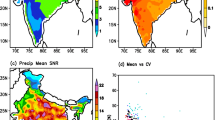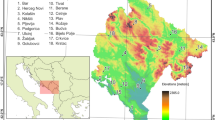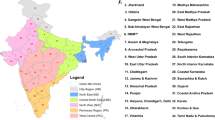Abstract
Aridity is a major indicator for defining the area of land that is prone to drought, land degradation, and desertification. The present research explores spatiotemporal variations of aridity using four different equations: (1) de Martonne aridity index (IDM); (2) Thornthwaite aridity index (AI); (3) moisture coefficient by V. I. Mezentsev (MI) and (4) Hydrothermal coefficient by Selyaninov (HTC) over Mongolia based on the primary climatic data from 70 different stations in Mongolia for the last 55 years (1961–2015). Utilizing these data using RegCM4-HadGEM climate change scenario, this study explores how the aridity level is likely to change in the future. The results showed that the total area of drylands (i.e., hyper-arid, arid, semi-arid and sub-humid regions) determined by IDM, MI, AI and HTC is approximately 64.1%, 70.7%, 85%, and 98%, respectively. Out of the four aridity indices considered, the metrics defined by AI and MI showed high correlation with the NDVI derived dryland regions. Time series analysis of AI and MI both showed a decreasing tendency for the period of 1961–2015. In the central and the northeastern regions in Mongolia, significantly decreasing trends in the aridity indices were observed. With respect to the stations with significantly decreasing trends in aridity, the relative changes of the aridity index magnitude varied between 14% and 74%. The aridity index calculated using climate change scenarios also indicated that the aridity level is likely to increase in the twenty-first century in the central part of Mongolia, whilst the extra arid areas will stable. The study has implications for water resources management, agriculture and social and economic life of the people of Mongolia and the other regions globally where aridity presents a significant challenge for decision makers.




Similar content being viewed by others
References
Agnew C, Anderson W (1992) Water in the Arid Realm. Routledge, London
American Meteorological Society (2006) Glossary of meteorology. http://amsglossary.allenpress.com/glossary
Baltas E (2007) Spatial distribution of climatic indices in northern Greece. Meteorol Appl 14:69–78
Batima P, Dagvadorj D (2000) Climate change its impacts in Mongolia. JEMR Publishing, Ulaanbaatar, pp 97–199
Batjargal Z (2007) Fragile Environment. Vulnerable People and Sensitive Society. Kaihatsu-sha Col Ltd, Tokyo
Chang Sh, We B, Yan N et al (2017) Suitability assessment of satellite-derived drought indices for Mongolian grassland. Remote Sensing 9:650. https://doi.org/10.3390/rs9070650
Chen Y, Deng H, Li B et al (2014) Abrupt change of temperature and precipitation extremes in the arid region of Northwest China. Quatern Int 336:35–43
Croitoru AE, Piticar A, Imbroane AM et al (2013) Spatiotemporal distribution of aridity indices based on temperature and precipitation in the extra-Carpathian regions of Romania. Theoret Appl Climatol 112:597–607
de Martonne E (1925) Traité de Géographie Physique. 3 tomes. Paris
Deniz A, Toros H, Incecik S (2011) Spatial variations of climate indices in Turkey. Int J Climatol 31:394–403
Du J, Fang J, Xu W et al (2013) Analysis of dry/wet conditions using the standardized precipitation index and its potential usefulness for drought/flood monitoring in Hunan Province, China. Stoch Env Res Risk Assess 27(2):377–387
Erdenetuya M, Hudulmur S (2009) Land cover change and pasture estimation of Mongolia from space. Geospatial world https://www.geospatialworld.net/article/ land-cover-change-and-pasture-estimation-of-mongolia-from-space. Accessed in Dec 2017
Gilbert RO (1987) Statistical methods for environmental pollution monitoring. Van Nostrand Reinhold, New York
Gomboluudev P (2007) Future climate change in Mongolia—detailed assessment results of the regional from the global scale, using dynamic downscaling method. In: Proceeding of the scientific conference modern issues of water resources and sustainable agricultural development, ecology and sustainable development, vol. 8, pp. 56–59 (in Mongolian language)
Goulden CE, Nandintsetseg B, Ariuntsetseg L (2011) The geology, climate and ecology of Mongolia. In: Sabloff P (ed) Mapping Mongolia: situating Mongolia in the world from geologic time to the present. University of Pennsylvania Press, Philadelphia, pp 87–103
Hamed KH, Rao AR (1998) A modified Mann-Kendall trend test for autocorrelated data. J Hydrol 204:182–196
Hengl T (2007) A practical guide to geostatistical mapping of environmental variables. JRC, Italy
Hessl AE, Anchukaitis KJ, Jelsema C et al (2018) Past and future drought in Mongolia. Sci Adv 4(3):e1701832
Ivanov NN (1948) Landscape-climatic zones of the Earth. Zapiski Geograficheskogo obshchestva, novaya seriya 1:12–24 (in Russian)
Kafle HK, Bruins HJ (2009) Climatic trends in Israel 1970-2002: warmer and increasing aridity inland. Clim Change 96:63–77
Liu X, Zhang D, Luo Y et al (2012) Spatial and temporal changes in aridity index in northwest China: 1960 to 2010. Theoret Appl Climatol 112:307–316
MARCC (2010) Mongolian assessment report on climate change. Ministry of Environment and Green Development, Ulaanbaatar
Mavromatis T, Stathis D (2011) Response of the water balance in Greece to temperature and precipitation trends. Theoret Appl Climatol 104:13–24
Mezentsev VS (1955) More on the calculation of average total evaporation. Meteorol Hydrol 5:24–26 (in Russian)
Mezentsev VS, Karnatsevich IV (1969) Humidity of western Siberian plain. Gydrometizdat, Leningrad (in Russian)
Nastos PT, Politi N, Kapsomenakis J (2013) Spatial and temporal variability of the aridity index in Greece. Atmos Res 119:140–152
Natsagdorj L (2000) Climate Change. In: Batima P, Dagvadorj D (eds) Climate change and its impacts on Mongolia. JEMR Press, Ulaanbaatar, pp 14–43
Nicholson SE (2011) Dryland climatology. Cambridge University Press, Cambridge
Palmer WC, Havens AV (1958) A graphical technique for determining evapotranspiration by the thornthwaite method. Mon Weather Rev 86:123–128
Paltineanu C, Tanasescu N, Chitu E et al (2007) Relationships between the De Martonne aridity index and water requirements of some representative crops: a case study from Romania. Int Agrophysics 21:81–93
Pasquini AI, Lecomte KL, Piovano EL et al (2006) Recent rainfall and runoff variability in central Argentina. Quatern Int 158:127–139
Perevedentsev YuP, Sharipova RB, Vajnova NA (2012) Agriclimatic resources of Uliyanovsk region and their impacts on agriculture productivity. Vestnik Udmurtskogo Universiteta 2:120–126 (in Russian)
Pettitt A (1979) A non-parametric approach to the change-point problem. Appl Stat 28(2):126–135
Pohlert T (2016) Trend: non-parametric trend tests and change-point detection. R package version 0.2.0. https://CRAN.R-project.org/package=trend
Selyaninov TG (1928) On the agricultural estimation of climate. Proc Agric Meteorol 20:165–177 (in Russian)
Sen PK (1968) Estimates of the regression coefficient based on Kendall’s tau. J Am Stat Assoc 63:1379–1389
Tabari H, Marofi S (2011) Changes of pan evaporation in the west of Iran. Water Resour Manage 25:97–111
Tabari H, Talaee PH, Nadoushani SSM et al (2014) A survey of temperature and precipitation based aridity indices in Iran. Quatern Int 345:158–166
Theil H (1950) A rank-invariant method of linear and polynomial regression analysis. Proc Koninalijke Nederlandse Akademie van Weinenschatpen A 53:1397–1412
Thornthwaite CW (1948) An approach toward a rational classification of climate. Geogr Rev 38(1):55
Tong S, Lai Q, Zhang J et al (2018) Spatiotemporal drought variability on the Mongolian Plateau from 1980-2014 based on the SPEI-PM, intensity analysis and Hurst exponent. Sci Total Environ 615:1557–1565
Toros H, Deniz A, Incecik S (2008) Continentality and oceanity indices in Turkey. In: Twenty-first annual conference, PACON 2008, energy and climate change, innovative approaches to solving today’s problems, Ala Moana Hotel, Honolulu, Hawaii, USA
UNEP (1992) World Atlas of desertification. Edward Arnold, London
UNESCO (1979) Map of the world distribution of arid regions: Map at scale 1:25,000,000 with an explanatory note. UNESCO, Paris: MAB Technical Notes 7
Wang Z, Li J, Lai C et al (2018). Drying tendency dominating the global grain production area. Global Food Security, 16
Wu SH, Yin Y, Zheng D et al (2006) Moisture conditions and climate trends in China during the period 1971–2000. Int J Climatol 26:193–206
Yue S, Wang C (2004) The Mann–Kendall test modified by effective sample size to detect trend in serially correlated hydrological series. Water Resour Manag 18:201–218
Zhang Q, Xu CY, Zhang Z et al (2009) Changes in temperature extremes for 1960–2004 in Far-West China. Stoch Env Res Risk Assess 23:721–735
Zhang Q, Xu CY, Tao H et al (2010) Climate changes and their impacts on water resources in the arid regions: a case study of the Tarim River basin, China. Stoch Env Res Risk Assess 24:349–358
Author information
Authors and Affiliations
Corresponding author
Ethics declarations
Conflict of interest
None.
Rights and permissions
About this article
Cite this article
Nyamtseren, M., Feng, Q. & Deo, R. A Comparative Study of Temperature and Precipitation-Based Aridity Indices and Their Trends in Mongolia. Int J Environ Res 12, 887–899 (2018). https://doi.org/10.1007/s41742-018-0143-6
Received:
Revised:
Accepted:
Published:
Issue Date:
DOI: https://doi.org/10.1007/s41742-018-0143-6




